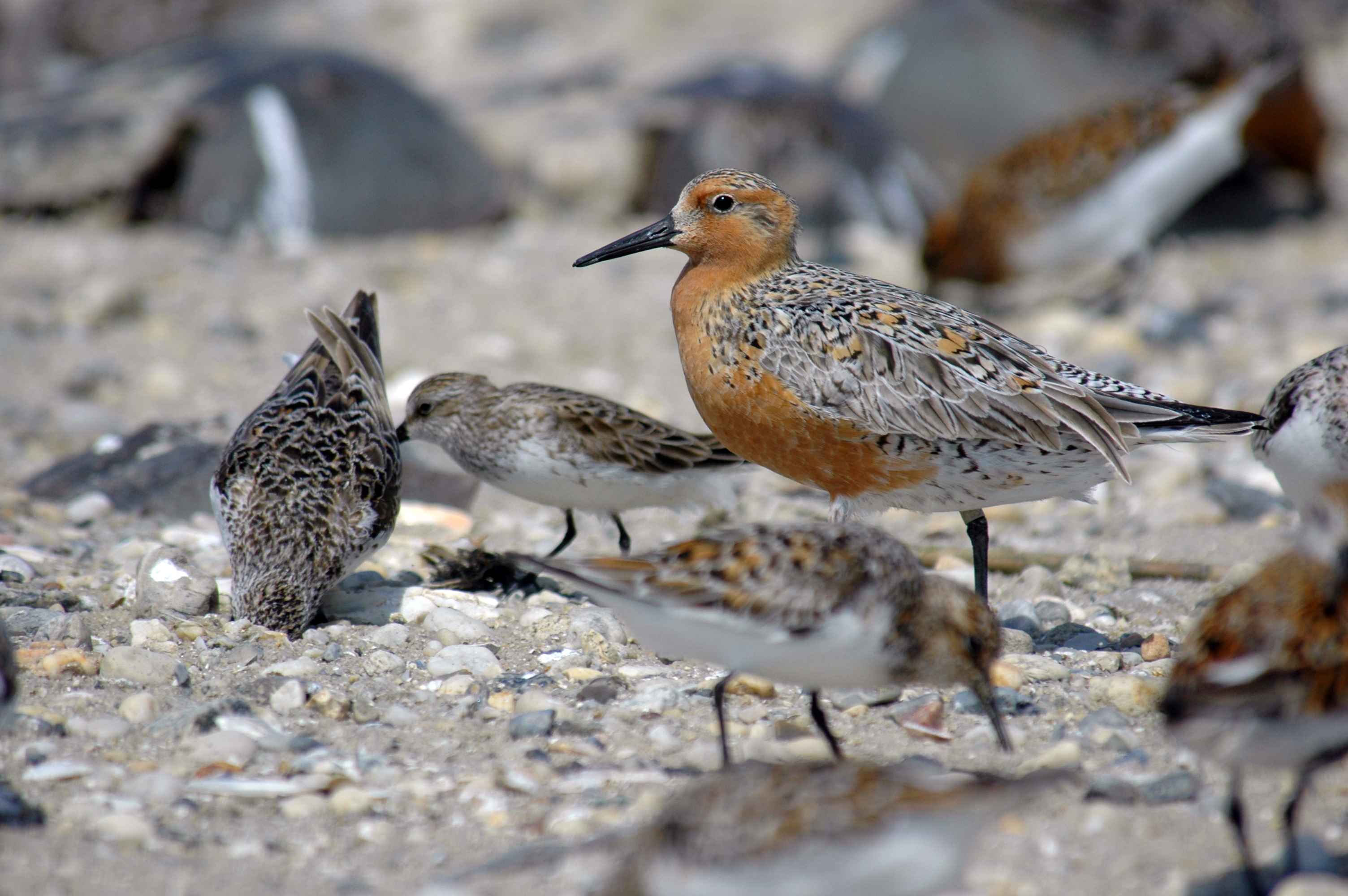Friday, Jun 30, 2017
By Susan Sorg, nature writer
Using its internal compass and the moon, stars, and sun, the rufa red knot makes one of the longest migrations on Earth, nearly a 20,000 mile round-trip flight from the southernmost tip of South America to its Arctic nesting grounds. Along the way, the red knot may face multiple risks - peregrine falcons, coastal development, and hurricanes. But since the overfishing of horseshoe crab in the 1990s, which caused a decline of the red knots' critical food, the population has plummeted.

to their breeding grounds in Canada. Graphic: Guilbert Gates.
Rufa red knot (Calidris canutus rufa) is a large sandpiper weighing an average of 4.8 ounces with a 20-inch wingspan, about the size of an American robin. There are three subspecies in North America and six species worldwide; rufa red knot is the eastern North American species. Their characteristic rusty 'rufous' plumage is the perfect camouflage in the Arctic breeding grounds to blend with wild grasses and wildflowers. In the fall they molt to a bland grey and white coloring for protection on the beaches of their South American wintering grounds.

Red knots and horseshoe crabs share a long history of interconnection, a delicate synchronicity of nature - the spawning of millions of horseshoe crab eggs in the Delaware Bay each spring is precisely timed with the red knots' arrival in May. On its northward migration, the red knots' key stopover is Delaware Bay - roughly half-way from their wintering grounds, Tierra del Fuego in Argentina to the Arctic nesting grounds.
Nothing in nature exists alone. The fragile relationship of the rufa red knot and the ancient horseshoe crab is one of nature's many delicate partnerships. With the decline of horseshoe crabs came the quick decline of the red knot - both populations have dropped about 75% since the 1990s. The rufa red knot is one of the most rapid and serious shorebird declines.
At Delaware Bay, the red knot must quickly refuel for energy to successfully complete the last leg of the long journey to the Arctic and breed. This event has been evolutionarily perfected over millions of year. When the red kntos arrive, they are exhausted and starved after four or more days flying nonstop from South America and must refuel with horseshoe crab eggs which provide easily digested protein. They can double their weight during this 12-14 day stopover, and this body fat is necessary to reach the Arctic and successfully breed.

older than dinosaurs. Photo: Jan Van De Kam.
Almost the entire eastern North American population of red knots will congregrate in Delaware Bay during spring migration. "Historically, more than 100,000 red knots stopped at Delaware Bay each spring. By 2004, this number had dropped to little more than 13,000" (American Bird Conservancy, February 2015). Although the horseshoe crab population is reported to have stabilized since improved protections restrict overfishing, concerns remain as to whether the crab population will recover fast enough for the red knot. Volunteers protect the Delaware Bay during spawning season, and horseshoe crabs used in medical research are also returned alive back to the ocean.
Climate change has now emerged as a greater threat. In 2014, the rufa red knot was listed as Threatened under the Endangerd Species Act and is the "first bird listed explicitly because its existence is imperiled by global warming" ("Red Knots Are Battling Climate Change - On Both Ends of the Earth," Deborah Cramer, Audubon Magazine; May/June 2016). Rising sea levels and storms may engulf the red knots' coastal habitat, and erratic temperatures can cause timing 'mismatches' (asynchronies) in nesting. Chicks need to hatch simultaneously with the insects' hatching to guarantee abundant food.
Coastal habitat conservation efforts in Michigan which benefit the endangered piping plover, pitcher's thistle, Houghton's goldenrod, and Lake Huron tansy also benefit the rufa red knot, as the species utilize similar habitat. Red knots are an uncommon migrant in Michigan and never abundant here, but could be spotted along Great Lakes shorelines heading north in late May or again in late July through September on their southern migration. In Michigan's Upper Peninsula it is possible to spot a red knot at MNA's Lake Superior Nature Sanctuary or Whitefish Point, and in the Lower Peninsula, Point Mouille State Game Area, Tawas Point State Park, and Lake Erie Metropark at the southeastern point of the state.

breeding and roosting habitats. Photo: Greg Breese.
Half the species of shorebirds in the United States and Canada are either endangered or of special concern, according to the U.S. and Canadian Shorebird Conservation Plans. The Western Hemisphere Shorebird Reserve Network has adopted a conservation strategy that is currently focusing on protecting 97 critical sites internationally, which includes Delaware Bay. For more information visit http://www.whsrn.org/western-hemisphere-shorebird-reserve-network and the USFWS at https://www.fws.gov/northeast/redknot/ to learn more.

Richard Anderson